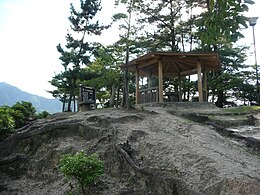Miyao Castle
| Miyao Castle | |
|---|---|
| (宮尾城?) | |
| Itsukushima, Hiroshima Prefecture, Japan | |

Location of the main courtyard.
|
|
| Coordinates | 34°18′02″N 132°19′21″E / 34.300554°N 132.322415°E |
| Type | Hill-on-Plains castle (平山城?) |
| Site information | |
| Controlled by | Hatsukaichi, Hiroshima |
| Open to the public |
24/7 |
| Condition | Site remains; main courtyard accessible. |
| Site history | |
| Built | 1555 |
| Built by | Mōri Motonari |
| In use | 1555 – ? |
| Materials | Earth, wood, stone. |
| Battles/wars | Battle of Miyajima |
Miyao Castle (宮尾城 miyao-jō?) was a fortification built on the island of Itsukushima (also known as Miyajima) during the Sengoku Period in Japan. Although referred to as a Japanese castle, it did not have a donjon (tenshu) or serve as the residence of a land-holding noble, and therefore is probably more within the definition of a hill fort, rather than a true castle. Built by Mōri Motonari, Miyao Castle was part of a greater plan to bait and trap his enemy, Sue Harukata, which culminated in the Battle of Miyajima in 1555.
The site of Miyao castle is located in Hamano-cho on the island of Miyajima, Hatsukaichi city, Hiroshima Prefecture.
In 1551, Sue Harukata revolted against his lord Ōuchi Yoshitaka, forcing him to commit seppuku. Sue effectively led the Ōuchi family and its armies, which ruled over Aki Province. In 1554, Mōri Motonari, as a fellow vassal of the Ōuchi clan, took up arms against Sue. The heavily outnumbered Mōri force attacked and defeated Sue at the Battle of Oshikibata. Mōri later departed from the mainland to build Miyao Castle on Itsukushima, popularly known as Miyajima.
As site for Miyao Castle, Mōri Motonari selected a 30-meter hill called Yougai-san (要害山?) in the northwest corner of the island, near the main shrine and overlooking the channel between Miyajima and the mainland. Miyao Castle was designed as a Hill-on-Plains castle (平山城 hirayamajiro?) on a piece of land at the foot of steep-sided mountains, including the 535-meter Mount Misen. The castle area could be approached by sea on three sides. Thus, Miyao Castle was intended to be highly visible and fairly vulnerable.
...
Wikipedia

